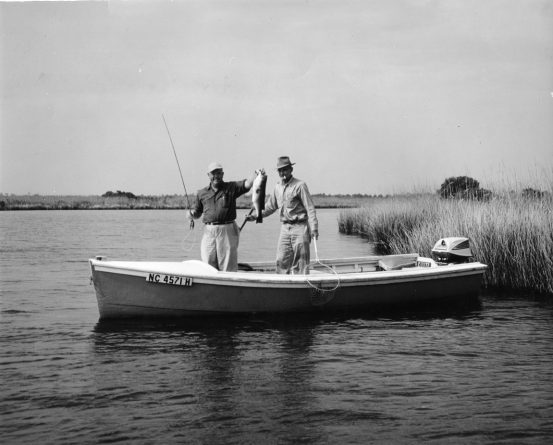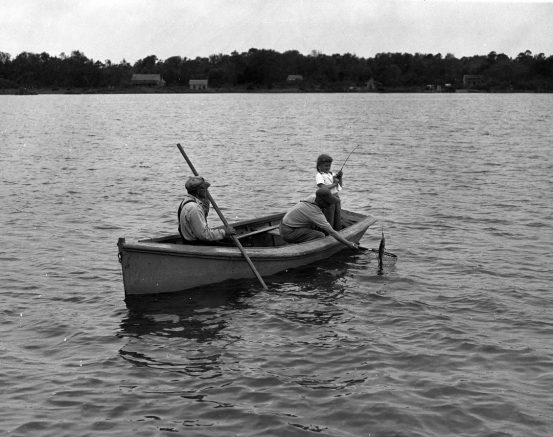When English explorer Arthur Barlowe and his ship first made landfall on the Outer Banks, the crew welcomed the Native Americans who came to greet them with gifts. The Indians climbed back in their canoes to show the English the abundance of the sea.

Writing about his experience when he returned to England, Barlowe recorded, “ . . . assoone as hee was two bow shoot into the water, hee fell to fishing, and in lesse then halfe an houre, he had laden his boate as deepe as it could swimme. . . “ Translation: As soon as he was two bow shots into the water, he fell to fishing and in less than half an hour, he had laden his boat as deep as it could swim.
The bounty of the sea has been a part of the history of the Outer Banks since before the first European explorers set foot upon its shores, and from that abundance has come a rich history of earning a living from the sea that has continued through modern times. Intertwined with this history are smugglers, rumrunners and boat designers.
The earliest Outer Banks settlers lived a subsistence life—growing enough crops from an infertile soil and hunting and fishing to feed themselves. What life on the sea taught early fishermen was where the shoals, sandbars and hidden inlets lay, and there is little doubt they supplemented their income with smuggling.

There was some commercial fishing, although it was very limited. Without refrigeration the fish would have been dried and salted before sale. Although the Outer Banks were considered a backwater, improvements in the U.S. transportation system after the Civil War made getting perishable products to market possible, and fishing as a way of life became viable.
However, the fishing boats of the time were not well suited for the conditions Outer Banks fishermen were encountering. Enter George Washington Creef—Roanoke Island resident, fisherman and designer of the Shad Boat that came into prominence in the late 19th century. With its high, sharp prow and rounded bottom with a wide body, the boat was steady in high seas and could carry a large load. The shad boat is the State Boat of North Carolina.
As an aside—building a shad boat required considerable skill, and that tradition of skilled boatbuilding has been handed down for over 125 years. It is an important part of the reason there is a thriving boatbuilding industry on the Outer Banks.
During Prohibition (1919-1933), the smuggling tradition was reignited when savvy Outer Banks sailors would scoot out to sea, pick up a load of rum and bring it to port before the Revenuers could get to them. Yet, it’s fishing that has remained a way of life into modern times.
On Hatteras Island, Hatteras Village and Avon were originally fishing towns, and both continue to support commercial fishing. When it was primarily a fishing village, Avon was named Kinakeet and a number of old time residents still refer to it that way.

The largest Outer Banks fishing port and the center of the commercial fishing industry is Wanchese, located on the south end of Roanoke Island. With multiple fish houses and modern dock facilities, it is the home port for most of the local commercial fishermen.
Although there are a number of fishermen still plying the waters of the sounds and sea, it is a way of life that is becoming more difficult on the Outer Banks. Funds for dredging Oregon and Hatteras Inlets have been cut, and without dredging, the inlets shoal up and become difficult if not impossible to navigate. There are also regulatory pressures, although local commercial fishermen have shown a remarkable ability to adapt to changing regulations.
Even with the pressures on the local fleet, the daily catch is still significant. The volume is compelling enough that when it states “catch of the day” on a local menu, it probably is!
